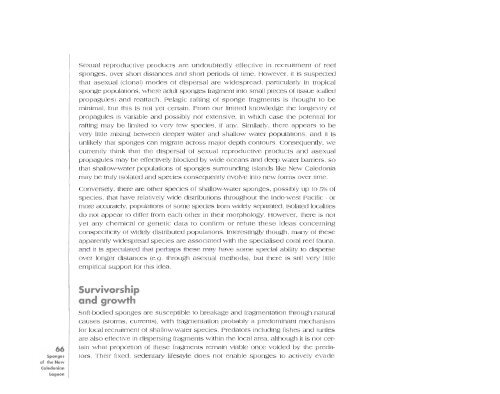Sponges of the New Caledonian lagoon - IRD
Sponges of the New Caledonian lagoon - IRD
Sponges of the New Caledonian lagoon - IRD
Create successful ePaper yourself
Turn your PDF publications into a flip-book with our unique Google optimized e-Paper software.
66<br />
<strong>Sponges</strong><br />
<strong>of</strong> <strong>the</strong> <strong>New</strong><br />
<strong>Caledonian</strong><br />
Lagoon<br />
Sexual reproductive products are undoubtedly effective in recruitment <strong>of</strong> reef<br />
sponges, over Sllort distances and short periods <strong>of</strong> time. However, it is suspected<br />
that asexual (clonal) modes <strong>of</strong> dispersal are Widespread, particularly in tropical<br />
sponge populations, where adult sponges fragment into small pieces <strong>of</strong> tissue (called<br />
propagules) and reattach. Pelagic rafting <strong>of</strong> sponge fragments is thought to be<br />
minimal, but this is not yet certain. From our limited knowledge <strong>the</strong> longevity <strong>of</strong><br />
propagules is variable and possibly not extensive, in which case <strong>the</strong> potential for<br />
rafting may be limited to very few species, if any. Similarly, <strong>the</strong>re appears to be<br />
very little mixing between deeper water and shallow water populations, and it is<br />
unlikely that sponges can migrate across major depth contours. Consequently, we<br />
currently think that <strong>the</strong> dispersal <strong>of</strong> sexual reproductive products and asexual<br />
propagules may be effectively blocked by wide oceans and deep water barriers, so<br />
that shallow-water populations <strong>of</strong> sponges surrounding islands like <strong>New</strong> Caledonia<br />
may be truly isolated and species consequently evolve into new forms over time.<br />
Conversely, <strong>the</strong>re are o<strong>the</strong>r species <strong>of</strong> shallow-water sponges, possibly up to 5% <strong>of</strong><br />
species, that have relatively wide distributions throughout <strong>the</strong> Indo-west Pacific - or<br />
more accurately, populations <strong>of</strong> some species from widely separated, isolated localities<br />
do not appear to differ from each o<strong>the</strong>r in <strong>the</strong>ir morphology. However, <strong>the</strong>re is not<br />
yet any chemical or genetic data to confirm or refute <strong>the</strong>se ideas concerning<br />
conspecificity <strong>of</strong> Widely distributed populations. Interestingly though, many <strong>of</strong> <strong>the</strong>se<br />
apparently Widespread species are associated with <strong>the</strong> specialised coral reef fauna,<br />
and it is speculated that perhaps <strong>the</strong>se may have some special ability to disperse<br />
over longer distances (e.g. through asexual methods), but <strong>the</strong>re is still very little<br />
empirical support for this idea.<br />
Survivorship<br />
and growth<br />
S<strong>of</strong>t-bodied sponges are susceptible to breakage and fragmentation through natural<br />
causes (storms, currents), with fragmentation probably a predominant mechanism<br />
for local recruitment <strong>of</strong> shallow-water species. Predators including fishes and turtles<br />
are also effective in dispersing fragments within <strong>the</strong> local area, altllough it is not cer<br />
tain what proportion <strong>of</strong> <strong>the</strong>se fragments remain viable once voided by <strong>the</strong> predators.<br />
Their fixed, sedentary lifestyle does not enable sponges to actively evade

















